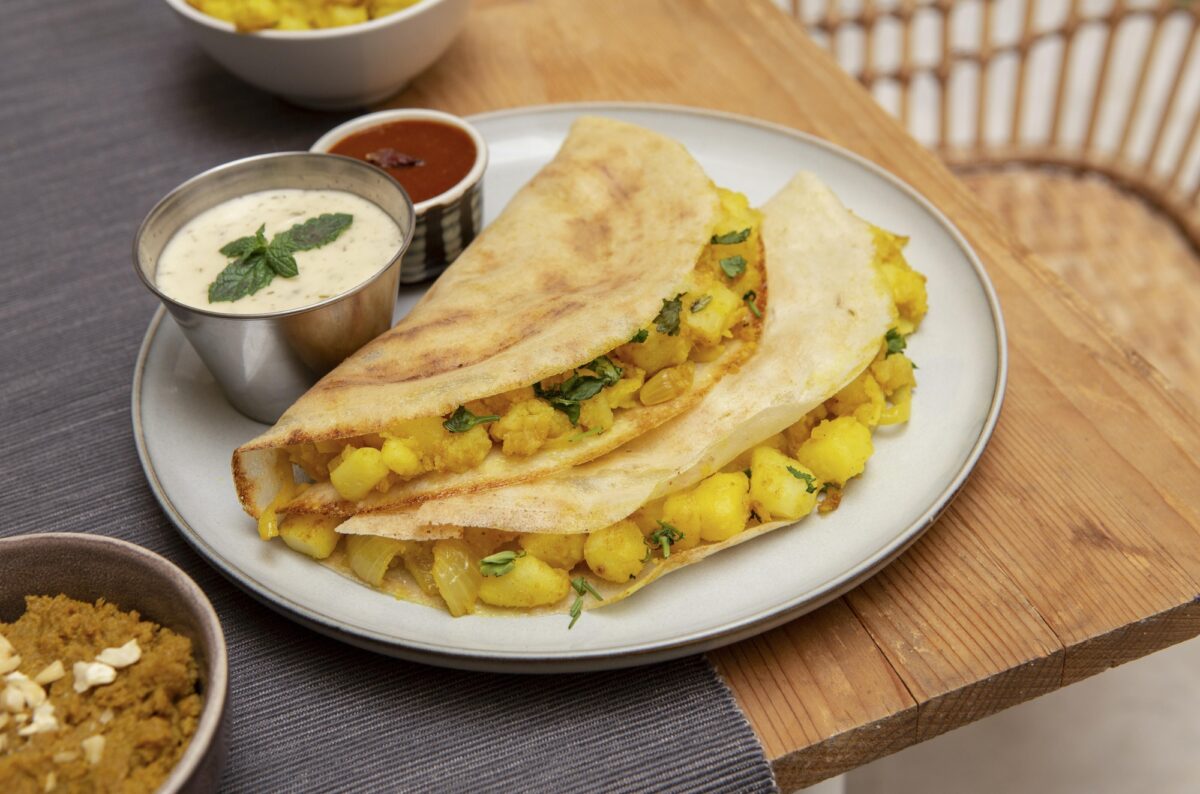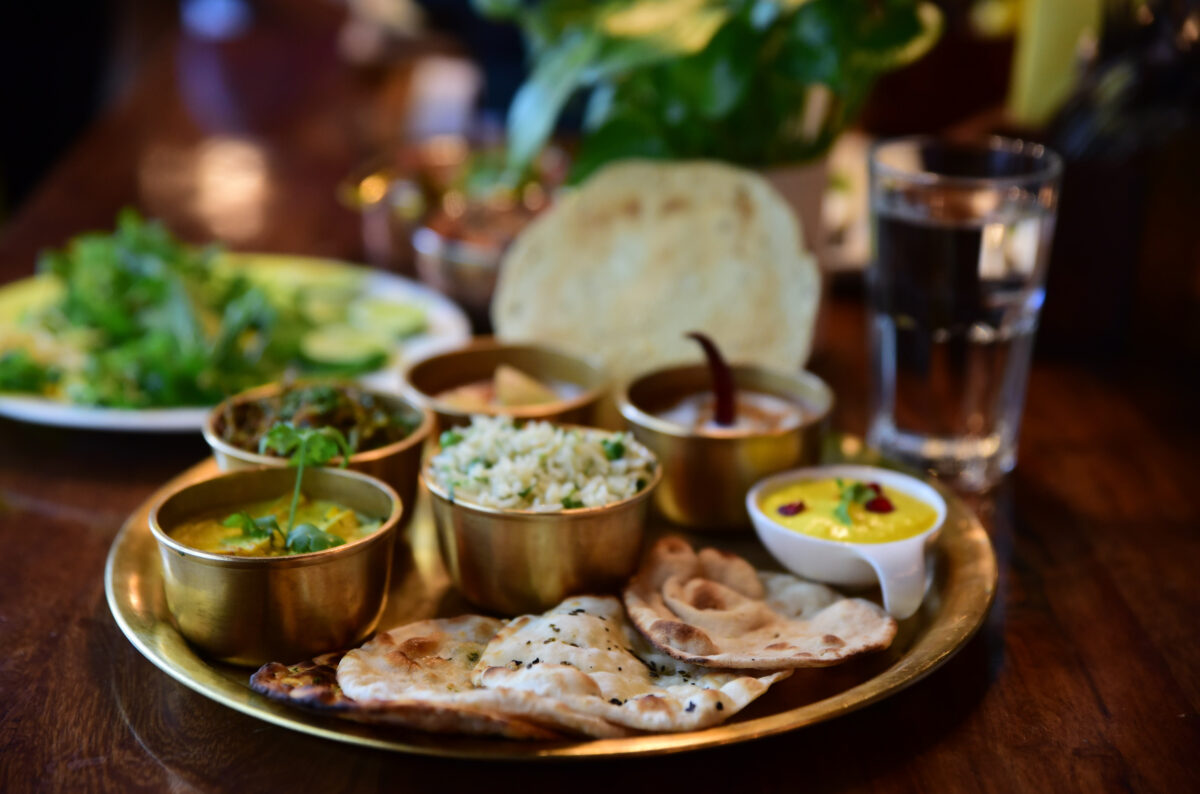
- March 28, 2025
Lunch South Indian Food Menu: The Ultimate Guide to a Traditional & Nutritious Meal
Are you looking for a Lunch South Indian Food Menu that is delicious, healthy, and fulfilling? South Indian cuisine is known for its balanced flavors, rich nutritional value, and use of fresh ingredients. A traditional South Indian thali offers a variety of dishes that complement each other, making it one of the best healthy lunch options for vegetarians.
A well-prepared Lunch South Indian Food Menu includes steamed rice, flavorful curries, crunchy sides, cooling yogurt, and a sweet dessert to round off the meal. Whether you’re making it at home or enjoying it at a south indian restaurant, this meal is not just about taste but also about nourishment. In this guide, we will explore the essential components of a Vegetarian meal menu, its health benefits, preparation tips, and where to find the best traditional thalis.
What is a South Indian Thali?
A South Indian thali is a traditional meal that consists of a variety of dishes served together, typically on a banana leaf or a large steel plate. It offers a perfect balance of carbohydrates, proteins, fibers, and essential nutrients. A thali is more than just a meal—it is a representation of South India’s rich culinary heritage.
A typical Lunch South Indian Food Menu includes:
- Steamed Rice – The staple of every South Indian meal, served with ghee for added flavor.
- Sambar – A lentil-based curry with vegetables, rich in proteins.
- Rasam – A tangy, spiced soup that aids digestion.
- Poriyal – Stir-fried vegetables, usually cooked with coconut and spices.
- Kootu – A lentil and vegetable stew that adds creaminess to the meal.
- Vatha Kuzhambu – A tamarind-based spicy curry with a deep, rich flavor.
- Appalam – Crispy papadum for a crunchy texture.
- Pickle – A tangy and spicy side to enhance taste.
- Curd – Yogurt that cools the palate and aids digestion.
- Payasam – A traditional South Indian dessert made with milk and jaggery.
Each of these dishes is designed to create a healthy lunch option, ensuring a satisfying meal while maintaining nutritional balance.
Components of an Authentic South Indian Lunch Menu
A traditional Lunch South Indian Food Menu is not just about eating; it’s about experiencing a variety of flavors that balance spiciness, tanginess, crunchiness, and sweetness. Each component of the meal serves a unique purpose and contributes to overall health and satisfaction.
Staple Food (Rice & Breads)
Rice is the heart of any South Indian meal, forming the base of the South Indian thali. Most dishes are designed to be eaten with rice, making it an essential component. There are several variations of rice dishes included in the meal:
- Steamed White Rice – The most common and traditional choice, usually served with ghee for added flavor.
- Brown Rice or Red Rice – A healthier alternative, often preferred in Kerala.
- Flavored Rice Varieties:
- Lemon Rice – A tangy rice dish with a hint of turmeric and mustard seeds.
- Coconut Rice – A mildly sweet, coconut-flavored rice, popular in Tamil Nadu.
- Tomato Rice – A spicy and flavorful rice dish with tomatoes and aromatic spices.
- Chapati or Parotta – Though not as common, some South Indian regions include these wheat-based breads in their lunch menus.
Main Curries (Sambar, Rasam, Kuzhambu)
The highlight of a Lunch South Indian Food Menu is its flavorful curries. These gravies and soups are packed with proteins and essential nutrients.
- Sambar – A thick lentil-based curry made with vegetables like drumsticks, carrots, and brinjal. It is packed with proteins, vitamins, and minerals.
- Rasam – A light, spicy soup made with tamarind, tomatoes, and pepper. It aids digestion and boosts immunity.
- Vatha Kuzhambu – A tamarind-based curry with dried berries or vegetables, known for its bold flavors and medicinal properties.
- More Kuzhambu – A yogurt-based curry that provides a cooling contrast to the spicy dishes.
Vegetable Side Dishes (Poriyal & Kootu)
No South Indian meal is complete without nutritious vegetable sides. These dishes ensure that the meal is fiber-rich and well-balanced.
- Carrot Beans Poriyal – Stir-fried vegetables seasoned with mustard seeds, curry leaves, and grated coconut.
- Pumpkin Kootu – A thick, lentil-based vegetable stew that adds a creamy texture to the meal.
- Avial – A Kerala specialty made with mixed vegetables, yogurt, and coconut.
Accompaniments & Condiments
Accompaniments enhance the overall taste of a Vegetarian meal menu, making each bite more exciting.
- Appalam (Papad) – A crunchy, deep-fried or roasted snack that adds texture to the meal.
- Pickles – Spicy and tangy pickles made from mango, lemon, or garlic.
- Buttermilk – A cooling, probiotic-rich drink that aids digestion.
Desserts
A meal is never complete without a touch of sweetness, and South Indian cuisine offers a variety of traditional desserts.
- Semiya Payasam – A creamy, milk-based dessert made with roasted vermicelli and sweetened with jaggery or sugar.
- Kesari – A saffron-flavored semolina dessert that is rich and aromatic.
This carefully curated menu ensures that a Lunch South Indian Food Menu is both delicious and nutritionally complete.
Where to Find the Best South Indian Thali?
If you’re looking for an authentic Lunch South Indian Food Menu, visit some of the best South Indian restaurants in different cities including Ahmedabad, Mumbai and Delhi
These places serve traditional thalis that are packed with flavors and authenticity.
How to Prepare a South Indian Thali at Home?
Preparing a traditional Lunch South Indian Food Menu at home might seem overwhelming, but with the right approach, it can be both enjoyable and efficient. South Indian meals are known for their elaborate nature, but with some smart techniques, you can simplify the process without compromising on taste.
Time-Saving Cooking Tips
- Plan Your Menu – Decide on the dishes you want to prepare in advance to avoid last-minute confusion.
- Use a Pressure Cooker – Cooking dal and rice in a pressure cooker significantly reduces cooking time.
- Make Spice Mixes in Advance – Homemade sambar powder, rasam powder, and curry pastes save time and enhance flavor.
- Batch Cooking – Cook extra sambar or rasam and store them in the fridge for later use.
- Multi-task in the Kitchen – While one dish is cooking, chop vegetables or prepare tempering for another.
Essential Ingredients & Spices
South Indian cuisine is known for its distinct use of spices and flavoring agents. Some key ingredients include:
- Tamarind – Adds a tangy taste to rasam and kuzhambu.
- Curry Leaves & Mustard Seeds – Used for tempering and enhancing aroma.
- Coconut – A staple ingredient in poriyal, kootu, and desserts.
- Turmeric & Asafoetida – Known for their digestive and anti-inflammatory properties.
By following these steps, you can create a restaurant-style Lunch South Indian Food Menu at home effortlessly.
Health Benefits of a South Indian Vegetarian Meal
A Lunch South Indian Food Menu is not only flavorful but also incredibly healthy. South Indian meals are designed to provide a well-rounded diet with all essential nutrients.
Balanced Nutrition
- Rice provides the necessary carbohydrates for energy.
- Lentils in sambar and kootu are excellent sources of protein.
- Vegetables in poriyal and kootu ensure a good intake of fiber and vitamins.
Easily Digestible & Light on the Stomach
- Dishes like rasam, buttermilk, and yogurt-based curries aid digestion and prevent bloating.
- Minimal use of heavy creams and oils makes it a healthy lunch option.
Rich in Antioxidants & Immunity Boosting Properties
- Ingredients like turmeric, ginger, and black pepper have anti-inflammatory properties.
- Tamarind and garlic help in detoxifying the body.
Low in Unhealthy Fats
- Most dishes are steamed, sautéed, or lightly fried, keeping the fat content low.
- Use of coconut oil instead of refined oils enhances heart health.
A well-prepared South Indian thali is one of the best healthy lunch options, combining taste with wholesome nutrition.
Conclusion
A Lunch South Indian Food Menu is not just a meal but a culinary experience that brings together tradition, taste, and nutrition. Whether you make it at home or enjoy it at a restaurant, a South Indian thali is a fulfilling and wholesome option.
If you want to savor an authentic Vegetarian meal menu, visit Mysore Aduge and indulge in a delightful South Indian feast today!
Looking for a South Indian Food Franchise?
If you love South Indian cuisine and want to start your own business, consider investing in a South Indian food franchise. Mysore Aduge offers franchise opportunities in various locations, including:
Frequently Asked Questions
A traditional Lunch South Indian Food Menu includes rice, sambar, rasam, poriyal, kootu, appalam, pickle, curd, and payasam.
Some of the best dishes include sambar, rasam, lemon rice, avial, and semiya payasam.
Start with rice, add sambar, rasam, poriyal, and kootu, and complete the meal with curd and dessert.
Yes, a South Indian thali is a healthy lunch option as it contains a balanced mix of nutrients.
South Indian food is primarily rice-based and uses tamarind, coconut, and curry leaves, while North Indian food relies more on wheat, dairy, and aromatic spices.
Traditionally, it is served on a banana leaf for added flavor and health benefits.
Yes, you can use alternatives like raw mango, lemon juice, or yogurt.
For a truly authentic Lunch South Indian Food Menu, visit Mysore Aduge for a traditional, home-style dining experience.







